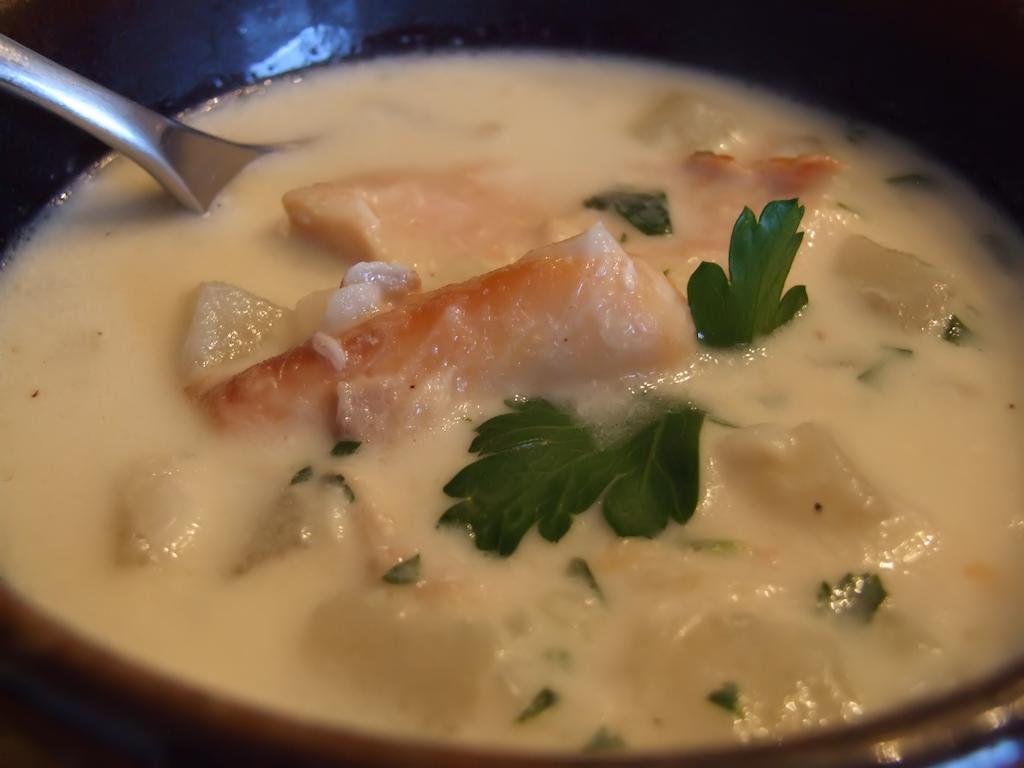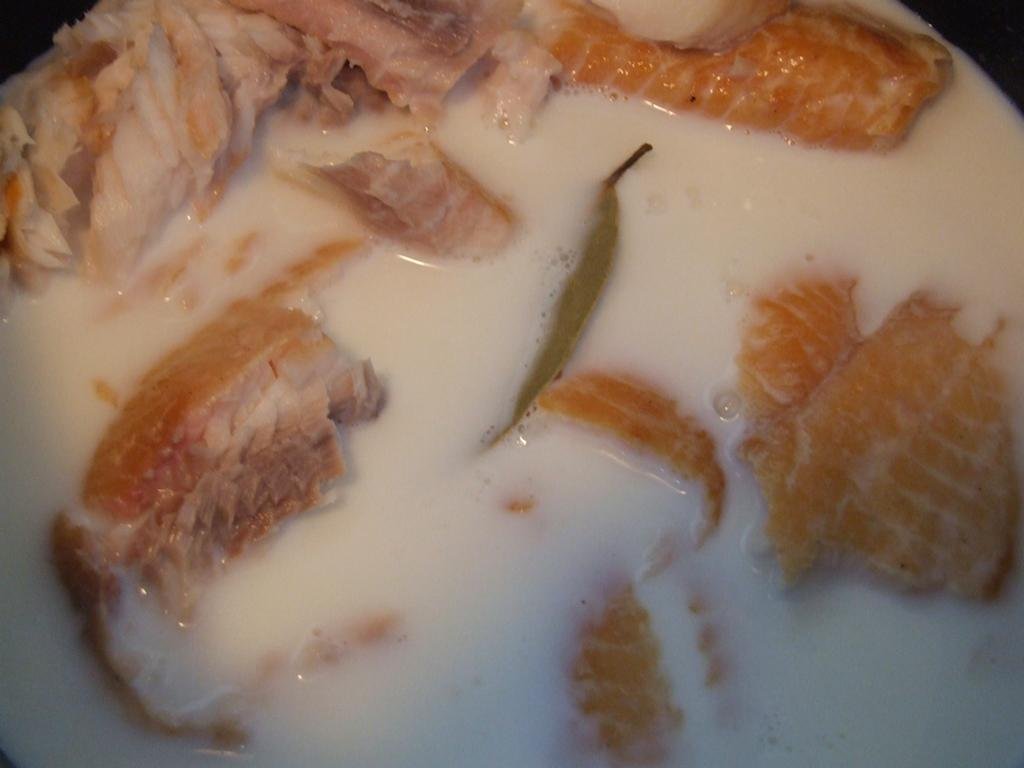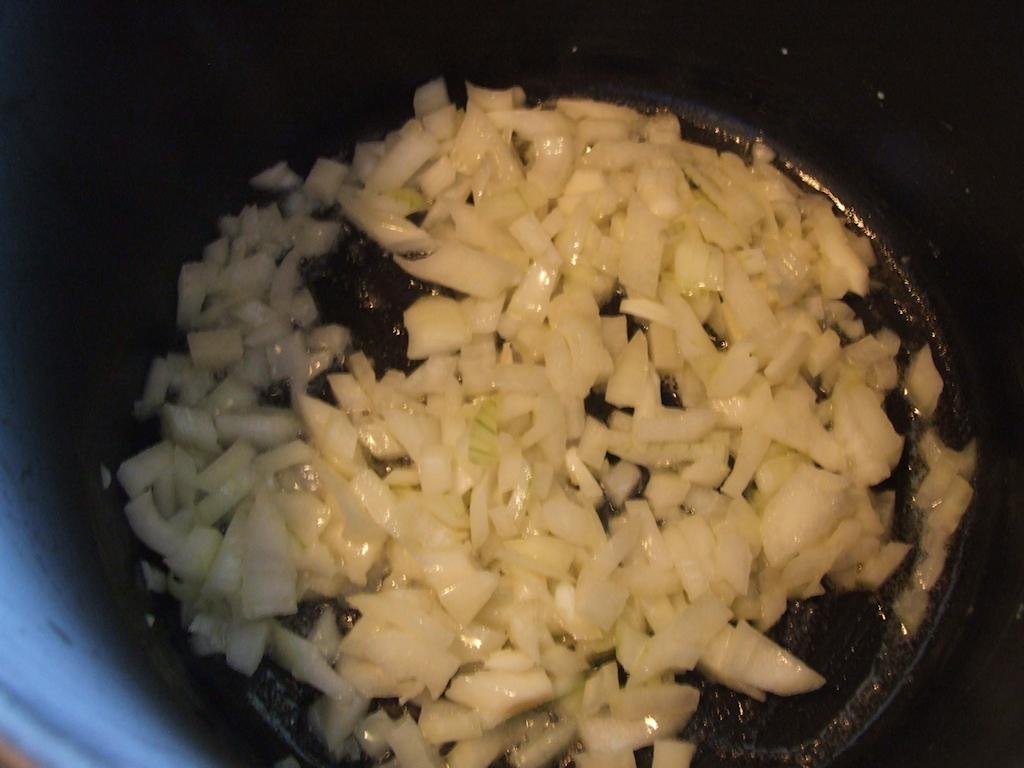 As used on UK Celebrity Masterchef 2014. Last night (10/7/14) Millie Mackintosh was given a basic recipe and our photo to make Cullen Skink. Unfortunately she made a stew and not a thick hearty soup.
As used on UK Celebrity Masterchef 2014. Last night (10/7/14) Millie Mackintosh was given a basic recipe and our photo to make Cullen Skink. Unfortunately she made a stew and not a thick hearty soup.Even though I know what ‘Cullen Skink’ is, this is one of the harder posts I’ve written. I grew up only a few miles away from Cullen, a small fishing village on the North East Coast of Scotland, where this fish soup is supposed to hail from. I’ve eaten it all my life, I know what it should taste like, and how to make it, but I’ve struggled to find definitive answers to its history. So unusually for me I’ll share my recipe first and write the history afterwards.
Cullen Skink Recipe
I prefer to keep the potatoes and the fish in my version of Cullen Skink chunky rather than mashed. This is a very rich and filling soup, with a wonderful smell and taste.
Total time: 50 mins
Ingredients
- 2lbs of smoked haddock (I used homemade smoked tilapia, since I can’t get smoked haddock in Houston)
- 1 medium onion, finely chopped
- 2 tbsp butter
- 1 pint (473ml) of full fat milk
- 0.75 pints (354ml) of single cream (half and half)
- 1lb (450g) of potatoes, cut into small cubes
- 1 bay leaf
- A handful of parsley, chopped
- Salt and freshly ground black pepper
Method
Place the fish in a pan, add the bay leaf and cover with milk. The milk should just cover the fish, if not, add a little more. Gently poach the fish for about 10 mins.
Gently remove the fish and place to the side.Strain the cooking liquor and place to the side.
In another pan, melt the butter and sauté the onions.
Add the potatoes and return the cooking liquor back to the pan. Bring to the boil, then reduce to a low simmer and cook for about 10 mins, until the potatoes are just soft.
Add the cream, the fish and the parsley to the pan. Gently heat the soup for a couple of minutes, being careful not to break up the fish and the potatoes too much. Taste for seasoning and add if required.
You can serve the soup straight away, but leaving it for a day, really improves the flavour.
It’s funny how ‘spooky’ some coincidences are. I made this soup a few Sundays ago, and on the Monday while I was doing the research of where the name came from I found that on the same day I made it, the Inaugural Cullen Skink World Championship took place in Cullen, Scotland. I’m sure I would have won it, I say so modestly, but there was a slight problem of me being 4500 miles away.
What is Cullen Skink? Well simply, it is a creamy soup made from smoked haddock and potatoes. The difficult part is how the name came about. Given that the main ingredient of Cullen Skink, Finnan haddie (a haddock that is smoked using green wood and peat) is found all along the North East coast of Scotland it seems likely that this soup was probably being cooked long before it was called Cullen Skink. I have yet to find a definitive answer on this.
The second part of the name, Skink, is another tricky thing to pin down. There are two popular theories on the name, but neither sound quite right. In old Scots, the word ‘skink’ means shin and would have come from the Middle Dutch word ‘schenke’ which also in turns gives us the English word ‘shank. Though people use beef shin bones for making soup, it doesn’t really explain how this relates to a fish soup. There is also a theory that the word comes from the Middle High German word for weak beer, liquor or essence.
I’m also suggesting that Cullen Skink may have been an influence for New England chowders. Given that the two soups are remarkably similar in regards to ingredients and that Finnan haddies are popular in the North East of the USA, it is possible that the soup travelled across the Atlantic. Some people have suggested it is French in origin and came from the word ‘chaudière’ meaning cooking pot, but there is no agreed answer to where and when New England chowders came from. The first reference to chowder was in a diary entry by Benjamin Lynde in 1732, but there is nothing before then.
Does anyone have more information on the real origins of Cullen Skink and Chowder?












12 comments
Skip to comment form
Hi.
I am a Scotsman and have lived in Denmark since 1980. I have only recently discovered the delights of Cullen Skink upon a visit to my homeland. My good friends had invited me to dinner and told me what would be served. I immediately assumed they would be serving a ham dish – “skinke” is ham in Danish, usually smoked. I suggest that the inhabitants of Cullen have replaced one ingredient with another, while retaining the name. Haddock was cheaper, perhaps?
Anyway, I didn`t complain.
Harry.
Author
Hi Harry,
What a coincidence. I’m a Scotsman too living in Copenhagen.
Cheers
Stu
What? No leeks? Oh dear.
Author
Onions yes, but I’ve never had or seen a Cullen Skink with leeks before
I found this post doing a Google search for Cullen Skink. Oddly enough, it was on the menu today at our local community college’s restaurant which serves food made by their culinary arts students. (I have been to Great Britain multiple times and have never heard of it and it showed up in Dover, DE?! Everyone at my table immediately passed on it because a SKINK is a small lizard and we all gagged on that thought! Glad to see the ingredients are more prosaic.
Just bought smoked haddock at champion seafood market on Louetta ?
Author
Wow! Do you think it is a regular item, or just a one off?
I lived in Aberdeen and the story of Cullen Skink, as I heard it, is as follows:
Cullen was a poor village on the Northeast coast of Scotland. Skink is a cheap stewing steak. Cullen was so poor they couldn’t afford ‘skink’ and so used smoked haddock instead. Hence the name ‘Cullen Skink’. However it got it’s name…..it’s the best soup ever!!!!!
Author
I think you’re on to something there. Similar to other foods such as Dunbar Wether or Gourock Ham https://wearenotfoodies.com/culinary-misnomers-or-danish-pastries-are-not-danish/
I love Cullen Skink. It has to be the best soup in the world. Well done on the recipe.
Hi here!!
We have decided that this will be our Christmas Day starter 🙂
Just wondering if you could let me know approximately how many servings the recipe makes?
Author
Hi Heather,
There should be enough to for between 4 & 6 bowls of soup, depending on the size of the bowls though.